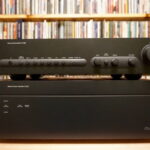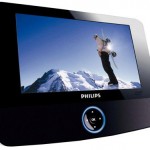I drink green tea the way some people drink water. I make it in large
batches, keep it in the fridge, and guzzle it all day. Such are the
dimensions of this innocuous drug habit that I blend
teas, often adding a pinch of Butterfly Sencha (with peach and
sunflower petals) to a standard Sencha, creating something more subtle
than the former and more interesting than the latter. (The Tea Squad
may burst through the door to arrest me at any moment.) I do the same
with surround equipment. This month, I've deliberately brought together
a receiver brand that prides itself on neutrality with a speaker brand
that obsesses about the purity and phase coherence of high frequencies.
Marantz, meet Tannoy. Tannoy, meet Marantz. What will happen next?

Higher Than High
As the Arena Highline 500 speaker system demonstrates, Tannoy has
done a lot of thinking about the tweeter. Like KEF, another icon of
British loudspeaker design, Tannoy believes that the best position for
a tweeter is in the center of a midrange/low-frequency driver. That
way, the two drivers can approximate a point source—that is, a wide
range of frequencies leap out of the speaker from the same position,
arriving at the ear at the same time, even when the listener is off
axis. Tannoy calls this a Dual Concentric array. (The generic term is coaxial.)
Another of Tannoy's departures from the norm is their tweeter's
frequency range. Most speakers extend up to about 20 kilohertz, a bit
beyond the range of most human hearing. Many speakers are rated up to
25 kHz. However, Tannoy prides themselves on extending the
high-frequency response of their WideBand tweeter to 54 kHz.
True, your ears will not hear that additional octave or so
directly (unless you're a small, furry animal). Even so, Tannoy
contends, this kind of high-frequency extension corrects time and phase
response in ways that affect audible highs, ensuring that the highs
your ears can hear are more coherent.
As I was breaking in the speakers, I casually put on an ancient harpsichord recording of Bach's Well-Tempered Clavier
by the legendary Wanda Landowska. This old set of LPs had been
gathering dust since a much younger version of me bought it long ago.
The early-1950s mono recording had always seemed dull and distant,
standing between the historic performance and me.
Hearing it through the Tannoys was like watching someone
suddenly leap out of a framed sepia-tinted picture. The plucking of the
harpsichord strings seemed like a vibrant physical phenomenon right
there in the room with me. Around the notes, there was air and space. I
was getting the feel,
if not the precise sonic characteristics, of surround sound from two
speakers reproducing a monaural recording. Let it suffice to say that
the Tannoy Arena Highline 500 system had gotten my attention.
Chosen Few
I can count the number of receiver brands I privately recommend to
friends and readers on the fingers of one hand and still have a few
fingers left. Marantz makes the "A" list. In addition to a reliably
neutral and ungimmicky midrange, the company also consistently delivers
a solid features set. The SR8001 A/V receiver is second from the top of
Marantz's line and is therefore well equipped to take on the challenges
of higher-end home theater.
Despite a rack-friendly reduction in depth to less than 16
inches, the copper-plated chassis still houses a large toroidal power
transformer. Power is rated at 125 watts times seven. Marantz prides
themselves on delivering at least 75 percent of the rated power into
five channels simultaneously driven. The HT Labs measurements box will
tell you if they succeeded. The receiver is THX Select2 certified and
therefore was proven to fill a 2,000-cubic-foot room with loud, clean
sound, when used with THX Select2–certified speakers, even before the
first production unit hit the shelves.
Worried about HDMI connectivity? The SR8001 has four inputs and
two outputs. It supports HDMI version 1.2, which handles all of the
major surround codecs old and new, except for Dolby TrueHD and DTS-HD
Master Audio. Those require HDMI 1.3 as far as a digital connection
goes, although this receiver can support them via the 7.1-channel
analog input. The main difference of interest to me between HDMI 1.1
and HDMI 1.2 is that the newer one is SACD friendly. You can output
video signals entering through the analog inputs (component, S-video,
and composite video) at 1080p with time-base correction.
If your room or speakers have acoustic problems—or you just
want to make life easier—the receiver's Audyssey MultEQ system might
help. It uses a microphone plugged into the front panel to sense the
type of speakers you're using and their distance from the listening
position, and it handles the necessary settings. It also tailors each
speaker's frequency response in one of four modes: Audyssey (or
"Audyssey knows best," as I call it), Front (all speakers matched to
the fronts), Flat (all speakers flat), or Preset (manual EQ settings).
I needed a stable frame of reference for this review, and I'd tried
Audyssey before, so I didn't use it much this time around. It might
benefit a system living in an acoustically problematic room, though,
especially in terms of bass response.
Gloss and Glamour
My Tannoy Arena Highline 500 review system consisted of two towers
and three satellites that I used for the center and surrounds. All are
sleek extruded-aluminum tubes with an attractive gloss finish. The
tower bases are rather small relative to the speakers' height, so you'd
be well advised to use the supplied spikes, if only to more safely
anchor the speakers to the floor. Optional stands for the smaller
speakers come fully assembled. You only need to affix the satellites
with lock washers and screws. Tannoy also includes wall-mount brackets.
A titanium dome tweeter is at the heart of Tannoy's Dual
Concentric array. The tweeter sits in the center of a 4-inch paper cone
midrange, and another 4-inch driver serves as an additional woofer (in
both the tower and the satellite). The grilles are nondetachable.
Because the speakers have relatively little bass extension due
to their small drivers and slender enclosures, I got the best results
when I used a subwoofer cross-over of at least 120 hertz. That means
you'll have to place the sub fairly close to the center speaker to keep
the lower registers of voices from detaching. Fortunately, the sub is a
marvel. It is narrow relative to its height and depth, so it doesn't
bulk large in the room. But it packs a 12-inch driver in its glossy
enclosure.
The sub's controls—found on top, which is worth a commendation
in and of itself—include a bypass switch and a continuously adjustable
phase control, in addition to the usual volume, crossover, and power
controls. One unusual item among the gleaming top-panel knobs is a
continuously adjustable Movie/Music control that trades off
low-frequency extension for maximum output level. Music mode plays
lower, while Movie mode plays louder. The manual recommends that you
set it in the middle if you don't want to fuss with it.
The Marantz receiver gave the Tannoys the plentiful supply of
clean power they demanded. Be forewarned: If you feed these speakers
with a cheap receiver, they may punish you for it. But, give them an
abundant supply of clean watts, and you'll learn things you'd never
known before. For example, I never thought I could sit still for hours
and listen to a harpsichord recorded in mono.
 Lay Bare Every Effect
Lay Bare Every Effect
Movie soundtracks are a woven hodgepodge of natural and fake
sound—plus music, of course. Speaker systems blend these elements
either crudely or artfully. The Highlines broke from the pack and
precisely rendered every sound and laid bare every panning effect,
revealing the inherent artificiality of even the best soundtracks. As
advertised, the speakers also imaged beautifully. Their Dual Concentric
drivers easily pinpointed every sound in space, both side to side and
front to back. At first, I was taken aback; I found the overall impact
to be somewhat clinical compared with what I'm used to. But it didn't
take me long to adjust to the new flow of incoming information—and
start to love it.
Take The Black Dahlia, for instance. This grisly
noir-ish Brian De Palma suspenser has one of the most action-packed
soundtracks I've ever heard. I filled three pages of my notebook with
details about a street riot, a boxing match, numerous blows and
clubbings, gunshots, an earthquake, a shattering vase, and a falling
chandelier. Still, I never quite shook free of the sound engineer's
presence, as his work was schematically laid out and annotated in every
sonic detail.
Dialogue was as good as I've ever heard. Every actor became a
master enunciator. And Mark Isham's music was impressively varied, from
the moody solo trumpet, to k.d. lang's cameo appearance, to the amazing
moment—during a movie-within-the-movie scene—when a string orchestra
blossoms from mock-movie-house mono to full-frequency surround. The
matched coaxial drivers made this moment so pleasurable, I had to stop
the disc to replay it.
Crank is a hyperaggressive action flick with a simple premise:
Our hero (Jason Stratham) has been injected with a drug that compels
him to keep up a constant flow of adrenaline—or else he dies. This sets
off relentless mayhem with the jerky visual style of a sped-up video.
With panning effects racing around the channels, I finished this
87-minute concerto of violence feeling like I'd just drunk three cups
of espresso. The cowriters and codirectors are Mark Neveldine and Brian
Taylor. Remember those names.
Despite its rather insistent orchestral soundtrack, All the King's Men
was more memorable for the power of Sean Penn's oratory—delivered with
all of its masterful dynamics intact—and the spacious rendering of
crowd noise. The Dual Concentric drivers and eloquent sub had three
different train shots to excel with: one crossing the screen from left
to right, one zooming from front to back, and a conversational scene
underpinned by the low rumble of a train in motion, which created a
relaxing, rocking sensation.
Whither the Center?
Activity in the center channel is a good—and all too rare—thing in SACD
surround mixes. That's just one of the things that went right on Ann
Hampton Callaway's Blues in the Night
(Telarc). Her silky voice fuses blues and jazz in a mix of American
songbook classics and original tunes. The singer, pianist, string
bassist, and drummer stuck close to the front channels, and the
surrounds provided mainly ambience. The Tannoys organized the mids and
highs to a fare-thee-well, turning Callaway's inherent warmth into a
solid physical presence. Her sister Liz joined the inspired
juxtaposition of "Stormy Weather" and "When the Sun Comes Out."
A different approach to the center was apparent on the SACD release of Al Di Meola's Consequence of Chaos.
Although the center channel was not entirely silent, Di Meola's
skittering guitar resided mostly in the front left and right, with some
ambience leaking into the surrounds. This placed him a couple of feet
forward of the front speakers. Untethered from the center channel, he
might have weaved from side to side as I moved my head were it not for
the extremely tight imaging of Tannoy's Dual Concentric tweeter and
midrange. This left me free to concentrate on the guitarist's rapid
runs and his dizzying unison playing with the piano.
Hail to the Thief was full of the dazzling moves and unsettling
beauty I've come to expect from Radiohead. The emotional high point
might be "I Will," in which Thom Yorke's voice is a multitracked chorus
as he sings a lament backed only by one electric guitar. What could
have been an undifferentiated wash of vocal color instead came through
as several distinct Thoms. Out-of-phase elements triggered fascinating
effects in the surround channels, thanks to the Dolby Pro Logic II
Music mode.
Six months before his death, Leonard Bernstein recorded Mozart's unfinished Great Mass in C Minor
with the Bavarian Radio Symphony Orchestra. The DVD comes with DTS 5.1
and PCM stereo soundtracks (but, in an odd departure, no Dolby). In a
trenchant spoken introduction, made shortly after the Berlin Wall came
down, Bernstein boldly interpreted the work as a memorial to the
victims of war. That made the hushed "Ave Verum Corpus" quietly
devastating. With the Tannoy tweeters' extended treble and effortless
low-level resolution, I could almost sense dust motes in the airy
ambience of the cathedral.
Normally, it doesn't bother me much to shovel review gear in
and out of my system. But I felt some separation anxiety when the end
drew near for the Tannoy Arena Highline 500 and Marantz SR8001. The
last weekend they were around, I drank an entire bottle of Riesling,
gorged on favorite piano recordings, and played every sad song I could
think of. Living without that perfect image focus and spatial
virtuosity won't be easy.{mospagebreak}
Highlights
Tannoy Arena Highline 500 Speaker System:
• Prominent, delightfully airy high-frequency response
• Slim and alluring form factor
• Eloquent sub
At A Glance: Tannoy Arena Highline 500 Speaker System

Subwoofer: TS 500
Connections: Line-level stereo
Enclosure Type: Sealed
Woofer (size in inches, type): 12, paper cone
Power Rating (watts): 500 RMS
Crossover Bypass: Yes
Available Finishes: Gloss Black, Gloss Silver
Dimensions (H x W x D, inches): 18.9 x 8.7 x 14.9
Weight (pounds): 33.1
Price: $1,100
These listings are based on the manufacturer's stated specs; the HT
Labs box below indicates the gear's performance on our test bench.
Speaker: Highline 500 Tower
Type: Two-way
Tweeter (size in inches, type): 0.75, titanium dome
Midrange (size in inches, type): 4, multifiber paper cone
Woofer (size in inches, type): 4, multifiber paper cone
Nominal Impedance (ohms): 8
Recommended Amp Power (watts): 25–100
Available Finishes: Gloss Black, Gloss Silver
Dimensions (H x W x D, inches): 45.69 x 8.23 x 7.76 (with base)
Weight (pounds): 30.8
Price: $900/each
Speaker: Highline 500 Centre and Satellite
Type: Two-way
Tweeter (size in inches, type): 0.75, titanium dome
Midrange (size in inches, type): 4, multifiber paper cone
Woofer (size in inches, type): 4, multifiber paper cone
Nominal Impedance (ohms): 8
Recommended Amp Power (watts): 25–100
Available Finishes: Gloss Black, Gloss Silver
Dimensions (H x W x D, inches): 23.34 x 5.98 x 4.88 *
Weight (pounds): 14.3
Price: $720/each + $189/stand/each
* Height and width are reversed for center
Ratings: Tannoy Arena Highline 500 Speaker System
Build Quality: 95
• Gleaming, glossy extruded-aluminum enclosures
• Titanium tweeters, paper woofers
• Solid metal stands
Value: 93
• A system retailing in the mid-four-figures is not exactly cheap
• But the innovation, build quality, and performance are worth the price
Features: 95
• WideBand tweeters for extended highs
• Tweeters and woofers in coaxial array
• Sub is adjustable for movie or music use
Performance: 91
• Open, airy, detailed when given clean power
• Pleasing reproduction of two-channel material
Ergonomics: 95
• Elegant profile enhances but won't dominate room
• Sub minimizes cabinet width while still delivering great bass
Overall Rating: 93
Tannoy goes over the top with extended treble response in the Arena
Highline 500 tower and satellite speakers. Once you've heard this
well-organized and revealing top end, with its abundant detail and
imaging, it may be hard to enjoy anything else.
General Information
Arena Highline 500 Tower Speaker, $900/each; Arena Highline 500 Centre/Satellite Speaker, $720/each
Arena Highline 500 Satellite Floor Stand, $189/each; Arena TS 500 Subwoofer, $1,100
Tannoy North America
(519) 745-1158
www.tannoy.com
HT Labs Measures: Tannoy Arena Highline 500 Speaker System

L/R Sensitivity: 88 dB from 500 Hz to 2 kHz
Center Sensitivity: 88.5 dB from 500 Hz to 2 kHz
Surround Sensitivity: 88 dB from 500 Hz to 2 kHz
This graph shows the quasi-anechoic (employing close-miking of all
woofers) frequency response of the 500 Tower L/R (purple trace), TS 500
subwoofer (blue trace), 500 Centre center channel (green trace), and
500 Satellite surround (red trace). All passive loudspeakers were
measured with grilles at a distance of 1 meter with a 2.83-volt input
and scaled for display purposes.
The 500 Tower's listening-window response (a five-point average
of axial and +/–15-degree horizontal and vertical responses) measures
+3.60/–3.01 decibels from 200 hertz to 10 kilohertz. The –3-dB point is
at 183 Hz, and the –6-dB point is at 129 Hz. Impedance reaches a
minimum of 3.39 ohms at 14.1 kHz and a phase angle of –58.66 degrees at
5.9 kHz.
The 500 Centre's listening-window response measures +2.14/–3.52
dB from 200 Hz to 10 kHz. An average of axial and +/–15-degree
horizontal responses measures +2.55/–3.80 dB from 200 Hz to 10 kHz. The
–3-dB point is at 174 Hz, and the –6-dB point is at 117 Hz. Impedance
reaches a minimum of 3.32 ohms at 14.6 kHz and a phase angle of –60.33
degrees at 139 Hz.
The 500 Satellite's listening-window response measures
+3.15/–2.44 dB from 200 Hz to 10 kHz. The –3-dB point is at 156 Hz, and
the –6-dB point is at 112 Hz. Impedance reaches a minimum of 3.34 ohms
at 14.1 kHz and a phase angle of –58.24 degrees at 5.9 kHz.
The TS 500's close-miked response, normalized to the level at
80 Hz, indicates that the lower –3-dB point is at 60 Hz and the –6-dB
point is at 53 Hz with the LF Extension control set to Music. The upper
–3-dB point is at 112 Hz with the LFE Mode switch set to On.{mospagebreak}
At A Glance: Marantz SR8001 A/V Receiver

Connections
Inputs:
Video: HDMI 1.2 (4) component video (4), S-video (4), composite video (3)
Audio: Coaxial digital (3), optical digital (3), 7.1-channel analog (1), stereo analog (6)
Outputs:
Video: HDMI 1.2 (2) component video (2) S-video (3), composite video (2), multizone composite (1)
Audio: Coaxial digital (1), optical digital (1), stereo analog (4), 7.1-channel preamp (1), stereo analog multizone (2)
Additional:
XM (1), RS-232 (1), DC trigger (2), IR receiver (1), IR emitter (2), RC-5 multizone in/out (2)
These listings are based on the manufacturer's stated specs; the HT
Labs box below indicates the gear's performance on our test bench.
Features
Processing Modes: Dolby: Digital 5.1, EX, Pro Logic IIx, Headphone
DTS: DTS, ES, 96/24, Neo:6
THX: Cinema, Select2 Cinema, Music, Games
Circle Surround II: Cinema, Music, Mono
Other: HDCD, Source Direct, Pure Direct
THX Certification: Yes, THX Select2
Audio D/A Converter: 24-bit/192-kilohertz
Number of Amp Channels: 7
Power Rating (watts per channel): 125 into 8 ohms; 160 into 6 ohms
Frequency Response: 8 Hz–100 kHz (analog in); 8 Hz–45 kHz (digital in)
Dimensions (H x W x D, inches): 7.3 x 17.25 x 15.6
Weight (pounds): 33.1
Price $2,000
Ratings: Marantz SR8001 A/V Receiver
Build Quality: 90
• Large toroidal power transformer
• Copper chassis
• Enclosure has a reduced depth
Value: 89
• Marantz's feature set is usually a step or two ahead of the pack
• Abundant HDMI, but it's 1.2, not the latest 1.3 version
Features: 92
• Rated at 125 watts times seven into 8 ohms, 160 into 6 ohms
• Audyssey MultEQ auto setup and room correction
Performance: 94
• Marantz always delivers a reliable midrange
• Good high-frequency character
Ergonomics: 89
• Big dial at left makes it easy to select source
• Remote LCD allows for one-button source selection
Overall Rating: 91
The Marantz SR8001 is a state-of-the-art surround receiver and, thanks
to its scrupulous neutrality, a fine mate for the Tannoys. Audyssey
auto setup and room EQ are big pluses.
General Information
Marantz SR8001 A/V Receiver, $2,000
Marantz America
(800) 654-6633
www.marantz.com
HT Labs Measures: Marantz SR8001 A/V Receiver

Five channels driven continuously into 8-ohm loads:
0.1% distortion at 102.1 watts
1% distortion at 121.0 watts
All channels driven continuously into 8-ohm loads:
0.1% distortion at 95.1 watts
1% distortion at 108.5 watts
Analog frequency response in Pure Direct mode:
–2.51 dB at 10 Hz; –0.78 dB at 20 Hz
–0.08 dB at 20 kHz; –0.51 dB at 50 kHz
Analog frequency response with signal processing:
–2.39 dB at 10 Hz; –0.74 dB at 20 Hz
–0.11 dB at 20 kHz; –44.38 dB at 50 kHz
This graph shows that the SR8001's left channel, from CD input to
speaker output with two channels driving 8-ohm loads, reaches 0.1
percent distortion at 156.4 watts and 1 percent distortion at 178.3
watts. Into 4 ohms, the amplifier reaches 0.1 percent distortion at
205.1 watts and 1 percent distortion at 250.5 watts.
Response from the multichannel input to the speaker output
measures –2.15 decibels at 10 hertz, –0.67 dB at 20 Hz, –0.08 dB at 20
kilohertz, and –0.53 dB at 50 kHz. THD+N from the amplifier was less
than 0.026 percent at 1 kHz when driving 2.83 volts into an 8-ohm load.
Crosstalk at 1 kHz driving 2.83 volts into an 8-ohm load was –79.21 dB
left to right and –78.39 dB right to left. The signal-to-noise ratio
with 2.83 volts driving an 8-ohm load from 10 Hz to 24 kHz with "A"
weighting was –92.49 dBrA.
From the Dolby Digital input to the loudspeaker output, the
left channel measures –0.49 dB at 20 Hz and –0.05 dB at 20 kHz. The
center channel measures –0.52 dB at 20 Hz and –0.11 dB at 20 kHz, and
the left surround channel measures –0.50 dB at 20 Hz and –0.11 dB at 20
kHz. From the Dolby Digital input to the line-level output, the LFE
channel is –0.04 dB at 20 Hz when referenced to the level at 40 Hz and
reaches the upper 3-dB down point at 117 Hz and the upper 6-dB down
point at 120 Hz.—MJP
 Need a Display?
Need a Display?
We recommend the following displays for use with this Tannoy/Marantz system:
Samsung HL-S6188W DLP HDTV, $3,300
Resolution: 1,920 by 1,080 (1080p)
Best Video Connection: HDMI
Weight: 79.4 pounds
 Pioneer Elite PRO-940HD Plasma HDTV, $3,300
Pioneer Elite PRO-940HD Plasma HDTV, $3,300
Resolution: 1,024 by 768
Best Video Connection: HDMI (2)
Weight: 69.9 pounds (with stand)
Reviewer:







